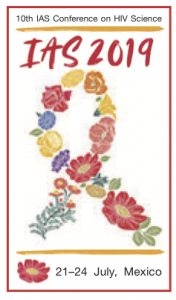WHO recommends dolutegravir-based ART regimens for all
24 July 2019. Related: Conference reports, Guidelines, IAS 10 Mexico City 2019.
 Polly Clayden, HIV i-Base
Polly Clayden, HIV i-Base
New World Health Organization (WHO) recommendations, released on 22 July 2019 at IAS 2019, include dolutegravir (DTG) as the preferred antiretroviral drug in first- and second-line regimens.
This recommendation recognises the declining estimate DTG-associated neural tube defect risk and observed efficacy.
The new policy brief is entitled: Update of recommendations on first- and second-line antiretroviral regimens July 2019. It is a forerunner to the revised 2019 WHO consolidated antiretroviral guidelines to be released later this year.
WHO now recommends tenofovir disoproxil fumarate (TDF)/lamivudine (3TC) or emtricitabine (FTC) (XTC)/DTG as the preferred first- and second-line ART regimen for adults, adolescents and children (with approved DTG dosing). Low dose efavirenz (EFV 400 mg) is now recommended for adults and adolescents as the alternative first-line ART.
Tenofovir alafenamide (TAF) is recommended in special circumstances for adults with established osteoporosis and/or impaired kidney function. It is recommended as part of an alternative first-line regimen for children of age and weight groups with approved dosing.
DTG-based first-line ART was previously recommended as an alternative regimen due to evidence gaps for its use in pregnancy, periconception and with rifampicin (RIF)-based tuberculosis (TB) treatment and lack of generic formulations at that time.
Since then, rapidly evolving evidence of safety and efficacy as well as programmatic data has accumulated on the use of DTG and efavirenz (EFV) 400 mg in pregnant women and people coinfected with TB.
Although risk of neural tube defects, associated with DTG, has declined since May 2018 it still remains slightly higher than with other ART exposure groups.
The new recommendations lift any previous restrictions on DTG for women of child-bearing potential. And WHO continues to emphasise the importance of a women-centred approach, providing women with up-to-date information on risks and benefits to make an informed choice.
The recommendations also highlight potential DTG-associated weight gain and the importance of a healthy diet and regular exercise to help manage weight.
See WHO ART recommendations Tables 1, 2 and 3.
Table 1: WHO recommendations July 2019
| First-line ART |
1. DTG in combination with a nucleoside reverse-transcriptase inhibitor (NRTI) backbone may be recommended as the preferred first-line regimen for people living with HIV starting ART
2. Efavirenz at low dose (EFV 400 mg) in combination with an NRTI backbone is recommended as the alternative first-line regimen for adults and adolescents living with HIV initiating ART (strong recommendation, moderate-certainty of evidence) 3. A raltegravir (RAL)-based regimen may be recommended as alternative first-line regimen for infants and children for whom approved DTG dosing is not available (conditional recommendation, low-certainty evidence) 4. A RAL-based regimen may be recommended as the preferred first-line regimen for neonates (conditional recommendation, very-low-certainty evidence) |
| Second-line ART |
1. DTG in combination with an optimised NRTI backbone may be recommended as a preferred second-line regimen for people living with HIV for whom non-DTG- based regimens are failing.
2. Boosted protease inhibitors in combination with an optimised NRTI backbone may be recommended as a preferred second-line regimen for people living with HIV for whom DTG-based regimens are failing (strong recommendation, moderate-certainty evidence) |
Table 2: Preferred and alternative first-line ART regimens
| Population | Preferred first-line regimen | Alternative first-line regimen | Special circumstances |
| Adults and adolescents | TDF + 3TC (or FTC) + DTG | TDF + 3TC (or FTC) + EFV 400 mg | TDF + 3TC (or FTC) + EFV 600 mg
AZT + 3TC + EFV 600 mg TDF + 3TC (or FTC) + PI/r TDF + 3TC (or FTC) + RAL TAF + 3TC (or FTC) + DTG ABC + 3TC + DTG |
| Children | ABC + 3TC + DTG | ABC + 3TC + LPV/r
TDF + 3TC + RAL TAF + 3TC (or FTC) + DTG |
ABC + 3TC + EFV (or NVP)
AZT + 3TC + EFV (or NVP) AZT + 3TC + LPV/r (or RAL) |
| Neonates | AZT + 3TC + RAL | ABC + 3TC + NVP | AZT + 3TC + LPV/r |
Key: AZT, zidovudine; DTG, dolutegravir; EFV, efavirenz; FTC, emtricitabine; LPV/r, ritonavir-boosted lopinavir; NVP, nevirapine; PI/r, ritonavir-boosted protease inhibitor; RAL, raltegravir; TAF, tenofovir alafenamide; TDF, tenofovir disoproxil fumarate; 3TC, lamivudine
Table 3: Preferred and alternative second-line ART regimens
| Population | Failing first-line regimen | Preferred second-line regimen | Alternative second-line regimen |
| Adults and adolescents | TDF + 3TC (or FTC) + DTG | TDF + 3TC + ATV/r (or LPV/r) | ABC + 3TC + DRV/r |
| TDF + 3TC (or FTC) + EFV (or NVP) | AZT + 3TC + DTG | AZT + 3TC + ATV/r (or LPV/r or DRV/r) | |
| AZT + 3TC (or FTC) + EFV (or NVP) | TDF + 3TC (or FTC) + DTG | TDF + 3TC (or FTC) + ATV/r (or LPV/r or DRV/r) | |
| Children and infants | ABC + 3TC + DTG | ABC (or AZT) + 3TC + LPV/r (or ATV/r) | ABC + 3TC + DRV/r |
| ABC (or AZT) + 3TC + LPV/r | ABC (or AZT) + 3TC + DTG | ABC (or AZT) + 3TC + RAL | |
| ABC (or AZT) + 3TC + EFV | ABC (or AZT) + 3TC + DTG | ABC (or AZT) + 3TC + LPV/r (or ATV/r) | |
| ABC + 3TC + NVP | ABC + 3TC + DTG | ABC (or AZT) + 3TC + LPV/r (or ATV/r or DRV/r) |
Key: ATV/r, ritonavir-boosted atazanavir; AZT, zidovudine; DTG, dolutegravir; DRV/r, ritonavir-boosted darunavir; EFV, efavirenz; FTC, emtricitabine; LPV/r, ritonavir-boosted lopinavir; NVP, nevirapine; PI/r, ritonavir-boosted protease inhibitor; RAL, raltegravir; TAF, tenofovir alafenamide; TDF, tenofovir disoproxil fumarate; 3TC, lamivudine
Reference
WHO. Update of recommendations on first- and second-line antiretroviral regimens. Policy brief. July 2019.
https://apps.who.int/iris/bitstream/handle/10665/325892/WHO-CDS-HIV-19.15-eng.pdf (PDF)

